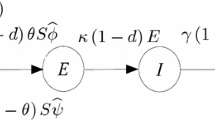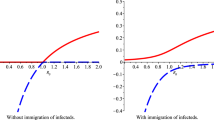Abstract
An S → I → R → S epidemiological model with vital dynamics in a population of varying size is discussed. A complete global analysis is given which uses a new result to establish the nonexistence of periodic solutions. Results are discussed in terms of three explicit threshold parameters which respectively govern the increase of the total population, the existence and stability of an endemic proportion equilibrium and the growth of the infective population. These lead to two distinct concepts of disease eradication which involve the total number of infectives and their proportion in the population.
Similar content being viewed by others
References
Anderson, R. M., May, R. M.: Population biology of infectious diseases: Part II. Nature 280, 455–461 (1979)
Anderson, R. M., May, R. M.: The population dynamics of microparasites and their invertebrate hosts. Philos. Trans. R. Soc. Lond., B 291, 451–524 (1981)
Busenberg, S., Cooke, K. L., Pozio, M. A.: Analysis of a model of a vertically transmitted disease. J. Math. Biol. 17, 305–329 (1983)
Busenberg, S., Cooke, K. L., Thieme, H.: Demographic change and persistence of HIV/AIDS in a heterogeneous population. Preprint (1989)
Castillo-Chavez, C., Cooke, K., Huang, W., Levin, S. A.: On the role of long incubation periods in the dynamics of acquired immunodeficiency syndrome (AIDS). Part 1: Single population models. J. Math. Biol. 27, 373–398 (1989)
Dietz, K., Hadeler, K. P.: Epidemiological models for sexually transmitted diseases. J. Math. Biol. 26, 1–25 (1988)
Hahn, W.: Stability of motion. Berlin Heidelberg New York: Springer 1967
Hall, W., Busenberg, S.: On the viscosity of magnetic suspensions. J. Chem. Phys. 51, 137–144 (1969)
Hethcote, H. W.: Qualitative analysis of communicable disease models. Math. Biosci. 28, 335–356 (1976)
Hethcote, H. W., Thieme, H. R.: Stability of the endemic equilibrium in epidemic models with subpopulations. Math. Biosci. 75, 205–227 (1985)
Jacquez, J. A., Simon, C. P., Koopman, J., Sattenspiel, L., Perry, T.: Modelling and analyzing HIV transmission: the effect of contact patterns. Math. Biosci. 92, 119–199 (1988)
May, R. M., Anderson, R. M., McClean, A. R.: Possible demographic consequences of HIV/AIDS epidemics: II, Assuming HIV infection does not necessarily lead to AIDS. Preprint (1988)
Mena-Lorca, J.: Periodicity and stability in epidemiological models with disease-related deaths. Ph.D. thesis, University of Iowa, 1988
Nold, A.: Heterogeneity in disease-transmission modeling. Math. Biosci. 52, 227–240 (1980)
Author information
Authors and Affiliations
Additional information
Partially supported by NSF Grant No. DMS-8703631. This work was done while this author was visiting the University of Victoria
Research supported in part by NSERC A-8965
Rights and permissions
About this article
Cite this article
Busenberg, S., van den Driessche, P. Analysis of a disease transmission model in a population with varying size. J. Math. Biol. 28, 257–270 (1990). https://doi.org/10.1007/BF00178776
Received:
Revised:
Issue Date:
DOI: https://doi.org/10.1007/BF00178776




